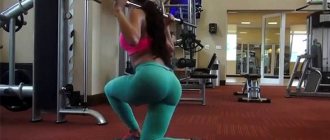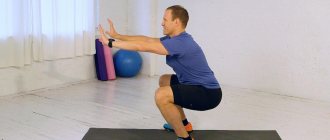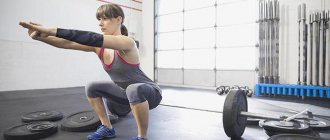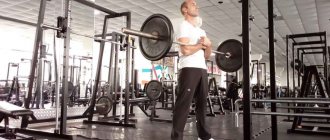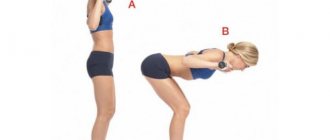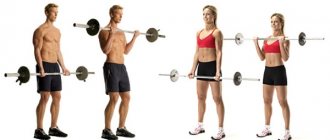About four problems with barbell squats and how to solve them.
Squats are one of the main human movements that work the largest muscles of the human body - the glutes, hamstrings and quadriceps.
There are many different variations of squats that can be found in the sports world, but when it comes to barbell training, there are only two types that are most common: high bar squats and low bar squats. Your choice will primarily depend on what goals you are pursuing when performing strength training. Some athletes prefer the low bar squat because the movement effectively engages the muscles in the back and back of the legs.
The higher the weight, the more muscles involved. Additionally, since low bar squats require the athlete to have a more horizontal body position, they also provide a good workout for the lower back muscles.
Although low bar squats will help you get stronger, it is not a method that requires you to follow your intuition and gut feelings . In other words, during the exercise you can break the technique, which at best will lead to ineffectiveness of the squat, and at worst, to injury.
So if you're experiencing discomfort and pain when performing low bar squats, you'll definitely need some advice from Matt Reynolds, personal trainer and owner of Barbell Logic, who will talk about possible problems in the movement and ways to solve them.
Matt Reynolds
Matt Reynolds has nearly 20 years of experience competing in strength sports. He first became an elite powerlifter in 2004, achieved his professional Strongman status in 2006, and founded one of the largest gyms in the United States, STRONG Gym, which won the PowerliftingWatch competition in 2013 and 2014. of the year).
Matt's articles on strength have been widely published since 1999. He also served as an adjunct professor in the Department of Exercise Science at Bryan University.
Matt founded and owns Barbell Logic; a company created to provide the highest quality online training and educational materials in the industry, from the best trainers on the planet, with unmatched customer service.
Matt is also the co-founder of the popular strength podcast, Barbell Logic, with fellow trainer Scott Hambrick, where they systematically and progressively walk the path of strength with their 150K listeners each month.
How does exercise help pump up the buttocks?
The only movement that allows you to use the large, medium and small muscles to the maximum is straightening the torso, and, therefore, squats are the best way to pump up these groups. And the lower you go, the more effective and efficient the exercise. Deep squats allow you to pump up and make your gluteal muscles elastic much faster.
Muscle strengthening occurs only when you work with weights. Training with weights helps muscles increase in volume. For each individual approach, 8-12 squats should be performed. After a cycle of repetitions, be sure to take a one- or two-minute break to rest.
You can't take light weight. The load must be noticeable. The correct choice is evidenced by the inability to perform more than 12 squats per approach. If there is no such refusal, the weights are too light. Of course, those who have never squatted with weights need to master the technique with a low load, and only then increase the weight at each session.
Squats. How to properly pump up your buttocks
Problem 1: Pain in the wrists, elbows and/or forearms
Solution: Correct your body position
“When people first start low-bar squatting,” says Matt, “they often complain of pain in their wrists, elbows, or forearms that follows them after finishing the exercise.”
Cause? Their body is not in quite the right position.
According to Matt, poor starting position is the most common problem people have with low bar squats. And the reason is simple - the correct position is very uncomfortable: when squats with a “low bar” you need to keep your shoulders, back and chest under a lot of tension.
YouTube
This tension forms a muscular “shelf” between the trapezius and rear deltoids, which holds the bar in place. Maintaining this position throughout the entire exercise can quickly become tiring, so people tend to relax. And that's when Matt says the problems begin.
“As you relax your shoulders and straighten your upper back, you will find it much more comfortable to squat in this position. But as you relax muscle by muscle, you will actually dismantle the “shelf” that held the bar on your back. At this stage, the arms come into play and are forced to hold the weight of the barbell. Excessive stress on the hands is what causes pain in the wrists/forearms/elbows .”
If your arms are trying to support 140 kg of weight on your back, this is a recipe for injury.
To secure the barbell, you will be forced to keep your wrists extended (bending your wrists back) or flexed (bending your wrists forward). And while the arm muscles have enough strength for this, the tendons clearly will not be happy with such a turn. Excessive stress will eventually lead to discomfort and even inflammation - tendinitis, which will force you to postpone training for several days or months.
Wrist extension. Wrong
Wrist flexion. Wrong.
So how do you fix the position problem?
Go back to the basics and make sure your barbell is in a secure position and you're holding it correctly. As a marker, use the bone of the scapula, which will be the top of your muscle “shelf”.
Grasp the barbell with a narrower grip, so that your wrists are neutral throughout the movement - in short, try not to bend or straighten them.
Open your chest to stretch your upper back. As you move upward, remember to keep your arms close to your body—this will help keep your wrists in a neutral position throughout the movement. By doing all this together, you will be sure that the weight of the bar is only on your back.
If at some point you begin to feel heaviness in your arms, it means that you have taken an incorrect position. Start from the beginning.
Many people find it difficult to get into the correct position for a low bar squat the first time. This requires some shoulder flexibility. If you've been hunched over like Quasimodo for years and can't get into the right position, Matt recommends a few practices:
- Stretch your upper back and shoulders with specific exercises. In short, be sure to stretch before exercising.
- Grasp the bar with an open grip - your thumbs and index fingers should form a ring around the bar. “Some people simply cannot perform the exercise with a closed grip because they lack flexibility in their shoulders. The second possible reason is that their forearms are slightly longer than their shoulders, Matt explains. – And that’s normal. Gripping the bar with a closed grip will help keep your wrists in a neutral position. In general, as long as you don’t feel the weight of the barbell in your hands, everything is fine.”
We recommend trying stretching first. If after several weeks of practice you still can't get into the correct squat position, change your grip.
see also
Squat with a barbell: technique, tips, nuances
Should your muscles hurt?
There is a belief that if you follow the correct technique for butt squats, it is important for girls to achieve pain after training. Allegedly, this is the result of the fact that the athlete really worked hard. In fact, pain occurs due to micro-tears in muscle fibers that are subject to unexpected stress. At the very beginning of training, this is inevitable - think for yourself, the quiet life of your buttocks was grossly disrupted, so to speak, they were taken out of their comfort zone and forced to work. Of course they will be indignant. However, once the muscles get used to it, there should be no pain. Except when you've increased the load a little.
Please note that pain can occur not only due to too high a load, but also simply because you did not warm up your muscles or missed a workout. Or they did not follow the technique correctly, overloading the joints.
Normally, painful sensations disappear, at most, a day after active exercise. Ideally, after 6-8 hours the body stops reminding you of the test. If you regularly finish exercise with excruciating pain, or it doesn't go away for weeks, you're clearly doing something wrong.
Let's sum it all up! Squats for the buttocks are a great exercise that makes them toned and elastic. It also forms slender legs and a beautiful tummy. Exercise has a beneficial effect on the entire body, maintaining muscle tone. Playing sports, any kind, increases self-esteem and mood, and the latter in pairs can work wonders! Good luck with your nuts!
Problem 2: lower back pain
Solution: Stop rounding your back
If you experience back pain when squatting, you may simply be rounding your lower back. In this case, according to Matt, at the bottom of the exercise your pelvis drops almost to the floor. “In this position, you look like a dog relieving itself,” Matt jokes.
Rounding of the lumbar and back
This occurs at the bottom of the squat due to the rounding of the lower back. Typically because: 1) keeping your lower back tense as you move down is extremely uncomfortable; 2) by rounding the lower back, it is easier for the athlete to lower into a deeper squat.
“Instead of dropping your hips below your knees, keeping your lower back tight, rounding your back allows you to squat much lower,” explains Matt.
The best way to avoid this problem is to “keep tension in your muscles.” If that doesn't work, Matt recommends a more crude technique: "pointing" your butt toward the wall behind you.
Technique for performing a deep squat without weights
Of course, you need to start doing deep squats without additional weight, even if you have success in classic squats. The exercise feels different, and in order to prevent unpleasant consequences, you should work on your technique.
Technique for performing deep squats without weight.
- Feet should be shoulder-width apart, for tall athletes - a little wider.
- Socks point slightly to the sides.
- The gaze is directed straight ahead, do not lower your head down.
- Since it can be quite difficult to maintain balance, you can stretch your arms out in front of you.
- The abs and buttocks are toned.
- The back is straight and rigid, the shoulder blades are brought together.
- As you inhale, we move your pelvis back and begin to smoothly lower down: when jerking, there is really a chance of harming your knees or lower back.
- Get below parallel with the floor, follow your feelings. Some people manage to reach their calves with their thighs, but for beginners with untrained leg muscles this will be difficult.
- Stay at the bottom for a couple of seconds and, as you exhale, slowly rise up.
Start with 8-10 repetitions and gradually increase to 15-18. For a beginner, 2-3 approaches will be enough; an experienced athlete can perform 4 or more.
Video: How to squat correctly? Technique for performing deep squats without weights
Problem 3: Hip Pain
Solution: Focus your weight on the center of your feet.
If you feel like you're falling backwards when you squat, you're probably putting too much of your weight in your heels. “When your toes feel like they're going to fly off the floor, it's not good,” warns Matt. “Over time, this can cause some problems in the lower body, such as hip pain.”
During the squat, your body weight should be concentrated in the center of the foot. Getting into this optimal position will take time and experience. “When you squat, your feet should literally be glued to the floor,” explains Matt.
see also
Lumberjack Squat Technique Helps Protect Your Knees
Problem 4: Knee Pain
Solution #1: Focus your weight on the center of your feet.
Much more often, athletes transfer most of their body weight not to their heels, but to their toes. “I see most people stand on their toes during the up and down motion,” Matt notes. “So they put their weight on their knees, and then they start complaining about pain.”
In this case, the solution is the same as in the example above: concentrate your body weight in, advises Matt.
Solution #2: Lower your torso
One reason you may be putting too much weight on your toes is due to poor torso positioning.
Unlike high bar squats, which require the torso to be upright while lowering, low bar squats require the athlete to tilt their torso. “It scares a lot of people because it doesn't feel natural,” says Matt. “They usually try to keep their torso upright because they are used to squatting with a high barbell position.”
If your body remains upright, your knees will inevitably move forward. And along with them, the bar moves forward. Then your body weight is transferred to your toes and you experience knee pain.
“As you lean further, your pelvis moves back. This position helps you keep your body weight in the center of your feet and engage your hamstrings, glutes, and adductors instead of putting stress on your knees,” says Matt.
What's the result? When performing low bar squats, simply lean your body forward as much as possible.
Solution #3: Start the upward movement from the hips
Another reason you're putting too much weight on your toes is because of your hips.
YouTube
The most common mistake during the upward movement is that people don't start at the hips. “A lot of athletes want to get their chest out as soon as possible - they feel like they're going to collapse in half because of how far they're bent over,” explains Matt. “Eventually they start to rise from the bottom of the squat. The hips shift forward, bringing the knees and body weight along with them, resulting in less efficient lifting and knee pain.”
To avoid this problem, start at the hips. First, push your glutes out of the bottom of the squat and then maintain a flexed position. Straighten your chest only when you have gone about 75% of the way.
As Matt notes, “Staying bent over is not only safer, it works more muscles: the lower back, glutes, hamstrings, and quads.”
Features of a deep squat. What are the benefits of exercise?
There is an opinion that deep squats can harm the knee joint. The fact is that deep squats may be contraindicated for people with knee injuries or diseases. Failure to follow the exercise technique can also lead to injury.
Why do my knees hurt?
During or after performing any squats, unpleasant or painful sensations in the knees may occur. There may be several reasons for this:
- A deep squat will be more difficult for an athlete with an ectomorph body type, who naturally has low levels of physical strength, thin muscles and narrow bones. The thigh muscles should serve as reliable protection for the knee during squats. If this does not happen, the load is too great. In this case, you need to very slowly, carefully, preferably with a good trainer, build muscle mass in your legs with exercises that are more gentle on the knee.
- Knees may hurt if there is inflammation of the meniscus or other diseases of the knee joint or joints in general. In this case, during the recovery period, loads should be excluded, and after exercise they should be selected by a doctor in such a way that they contribute to recovery.
Knee pain during any type of squats can be a sign of a serious problem. You need to see a doctor.
- The reason may also be the athlete’s low level of physical fitness. Beginners often have pain in their knees after any squat, but the discomfort (the level of pain is low and tolerable) goes away after 3-4 sessions. If the pain is sharp or lasts longer, this is a reason to consult a doctor.
The benefits of deep squats for the buttocks and other muscles
In addition to the benefits for the muscles of the thighs and buttocks, there are several advantages of deep squats:
- Deep squats can increase the stability of the knee joint and provide it with a long healthy life. The pressure inside the knee is reduced, which has a beneficial effect on the joint as a whole.
- The load on the buttocks increases by 25% compared to the classic version of squats, which helps build muscle mass in this area.
- Increased strength: due to the deep landing, the legs become very strong, so the exercise is indispensable for many athletes - athletes, runners, football players and many others.
- Low mobility of the knee in everyday life as a result of a sedentary lifestyle or lack of exercise leads to arthritis. Deep squats reduce the likelihood of developing this disease.
- Knee injuries and surgeries are easier to bear, and the joint itself recovers faster with regular deep squats.
